Application of Thermal Analysis to Evaluate Pharmaceutical Preparations Containing Theophylline
Abstract
1. Introduction
2. Results and Discussion
2.1. Thermogravimetric Analysis
2.2. c-DTA Measurements
2.3. UV-Vis Spectrophotometry Analysis
2.4. TGA and c-DTA Measurements of Prepared Counterfeit Formulations
3. Materials and Methods
3.1. Tested Samples
3.2. Preparation Drugs for Measurements
3.3. UV-Vis Spectrophotometry Analysis
3.4. Thermogravimetric (TG) and Differential Thermal Analysis (c-DTA) Measurements
3.5. Statistical Analysis
4. Conclusions
Funding
Institutional Review Board Statement
Informed Consent Statement
Data Availability Statement
Acknowledgments
Conflicts of Interest
References
- Zając, M.; Jelińska, A. Ocena Jakości Substancji i Produktów Leczniczych; Wydawnictwo Naukowe Uniwersytetu Medycznego im. Karola Marcinkowskiego w Poznaniu: Poznań, Poland, 2010. [Google Scholar]
- Parys, W.; Pyka-Pająk, A. TLC-densitometry for determination of omeprazole in simple and combined pharmaceutical preparations. Pharmaceuticals 2022, 15, 1016. [Google Scholar] [CrossRef] [PubMed]
- Polish Pharmaceutical Society. Polish Pharmacopoeia, 11th ed.; Polish Pharmaceutical Society: Warsaw, Poland, 2017. [Google Scholar]
- European Directorate for the Quality of Medicines & HealthCare. European Pharmacopoeia (Ph. Eur.), 10th ed.; EDQM: Strasbourg Cedex, France, 2021. [Google Scholar]
- ICH. ICH Harmonised Tripartite Guideline: Validation of Analytical Procedures: Text and Methodology, Q2(R1); ICH: Geneva, Switzerland, 2005. [Google Scholar]
- Holzgrabe, U. Nuclear Magnetic Resonance Spectroscopy | Identification of Counterfeit Drugs and Herbal Medicine. In Encyclopedia of Analytical Science, 3rd ed.; Worsfold, P., Poole, C., Townshend, A., Miró, M., Eds.; Academic Press: Cambridge, MA, USA, 2019; pp. 182–185. [Google Scholar]
- Talik, P.; Żuromska-Witek, B.; Hubicka, U.; Krzek, J. The use of the method in quantification of active pharmaceutical ingrdients in commercially available one component tablets. Acta Pol. Pharm. 2017, 74, 1049–1055. [Google Scholar]
- Monajjemzadeh, F.; Ghaderi, F. Thermal analysis methods in pharmaceutical quality control. J. Mol. Pharm. Org. Process Res. 2015, 3, e121. [Google Scholar]
- Swiss Pharmaceutical Socied. Index Nominum: International Drug Directory, 20th ed.; MedPharm: Stuttgart, Germany, 2011. [Google Scholar]
- Drug Bank. Available online: https://go.drugbank.com/drugs/DB01223 (accessed on 15 September 2022).
- Janiec, W. Farmakodynamika; PZWL: Warsaw, Poland, 2022. [Google Scholar]
- Ito, K.; Lim, S.; Caramori, G.; Cosio, B.; Chung, K.F.; Adcock, I.M.; Barnes, P.J. A molecular mechanism of action of theophylline: Induction of histone deacetylase activity to decrease inflammatory gene expression. Proc. Natl. Acad. Sci. USA 2002, 99, 8921–8926. [Google Scholar] [CrossRef] [PubMed]
- Barnes, P.J. Theophylline. Am. J. Respir. Crit. Care Med. 2013, 188, 901–906. [Google Scholar] [CrossRef]
- Nuhoglu, Y.; Nuhoglu, C. Aminophylline for treating asthma and chronic obstructive pulmonary disease. Expert Rev. Respir. Med. 2008, 2, 305–313. [Google Scholar] [CrossRef] [PubMed]
- Moseson, D.E.; Jordan, M.A.; Shah, D.D.; Corum, I.D.; Alvarenga, B.R., Jr.; Taylor, L.S. Application and limitations of thermogravimetric analysis to delineate the hot melt extrusion chemical stability processing window. Int. J. Pharm. 2020, 590, 119916. [Google Scholar] [CrossRef] [PubMed]
- Dołęga, A.; Juszczyńska-Gałązka, E.; Deptuch, A.; Jaworska-Gołąb, T.; Zieliński, P.M. Thermoanalytical studies of a cytotoxic derivative of carbamazepine: Iminostilbene. Therm. Anal. Calorim. 2021, 146, 2151–2160. [Google Scholar] [CrossRef]
- Guo, W.; Li, C.; Du, P.; Wang, Y.; Zhao, S.; Wang, J.; Yang, C. Thermal properties of drug polymorphs: A case study with felod pine form I and form IV. J. Saudi Chem. Soc. 2020, 24, 474–483. [Google Scholar] [CrossRef]
- Cordeiro, C.F.; Bettio, I.; Trevisan, M.G. Studies on the characterization and polymorphic stability of Fosamprenavir. An. Acad. Bras. Cienc. 2020, 92, 1–11. [Google Scholar] [CrossRef] [PubMed]
- Rojek, B.; Wesołowski, M. Compatibility study of theophyline with excipients using thermogravimetry supported by kinetic analysis. J. Therm. Anal. Calorim. 2021, 143, 227–236. [Google Scholar] [CrossRef]
- Ramos, P. Compatibility studies of selected mucolytic drugs with excipients used in solid dosage forms: Thermogravimetry analysis. Farmacia 2021, 69, 585–594. [Google Scholar] [CrossRef]
- Ramos, P. Thermal compatibility assessment of selected excipients used in the oral anti-cancer formulation containing busulfan. Farmacia 2022, 70, 417–424. [Google Scholar] [CrossRef]
- Mussel, V.A.F.S.N.; Ferreira, M.P.; Marques, M.B.F.; Yoshida, M.I.; Almeida, M.R.; Rodrigues, B.L.; Mussel, W.N. Physics, chemistry, and Hirshfeld surface analyses of gamma-irradiated thalidomide to evaluate behavior under sterilization doses. J. Pharm. Anal. 2018, 8, 194–201. [Google Scholar] [CrossRef]
- Ouerfelli, N.; Vrinceanu, N.; Mliki, E.; Homeida, A.M.; Amin, K.A.; Ogrodowczyk, M.; Alshehri, F.S.; Ouerfelli, N. Modeling of the irradiation efect on some physicochemical properties of metoprolol tartrate for safe medical uses. Sci. Rep. 2020, 10, 67. [Google Scholar] [CrossRef]
- Ramos, P.; Broncel, M. Influence of storage conditions on the stability of gum arabic and tragacanth. Molecules 2022, 27, 1510. [Google Scholar] [CrossRef]
- Saber, R.A.; Attia, A.K.; Salem, W.M. Thermal analysis study of antihypertensive drugs telmisartan and cilazapril. Adv. Pharm. Bull. 2014, 4, 283–287. [Google Scholar]
- Vyazovkin, S.; Koga, N.; Schick, C. Handbook of Thermal Analysis and Calorimetry, 2nd ed.; Elsevier: Cambridge, MA, USA, 2008. [Google Scholar]
- Razafindralambo, H.; Razafindralambo, A.; Blecker, C. Thermophysical fingerprinting of probiotic-based products. Sci. Rep. 2019, 9, 10011. [Google Scholar] [CrossRef]
- Schnitzler, E.; Kobelnik, M.; Sotelo, G.F.C.; Bannach, G.; Ionashiro, M. Thermoanalytical study of purine derivatives compounds. Eclética Quim. 2004, 29, 71–78. [Google Scholar] [CrossRef][Green Version]
- Ren, S.; Sun, X.; Lei, T.; Wu, Q. The effect of chemical and high-pressure homogenization treatment conditions on the morphology of cellulose nanoparticles. J. Nanomat. 2014, 2014, 582913. [Google Scholar] [CrossRef]
- Liebeck, B.M.; Hidalgo, N.; Roth, G.; Popescu, C.; Böker, A. Synthesis and characterization of methyl cellulose/keratin hydrolysate composite membranes. Polymers 2017, 9, 91. [Google Scholar] [CrossRef] [PubMed]
- Rivera-Galletti, A.; Gough, C.R.; Kaleem, F.; Burch, M.; Ratcliffe, C.; Lu, P.; Salas-de la Cruz, D.; Hu, X. Silk-cellulose acetate biocomposite materials regenerated from ionic liquid. Polymers 2021, 13, 2911. [Google Scholar] [CrossRef] [PubMed]
- Golbaghi, L.; Khamforoush, M.; Hatami, T. Carboxymethyl cellulose production from sugarcane bagasse with steam explosion pulping: Experimental, modeling, and optimization. Carbohydr. Polym. 2017, 174, 780–788. [Google Scholar] [CrossRef] [PubMed]
- Restiani Alia Pratiwi, R.A.; Nandiyanto, A.B.D. How to read and interpret UV-VIS spectrophotometric results in determining the structure of chemical compounds. Indon. J. Edu. Res. Tech. 2022, 2, 1–20. [Google Scholar] [CrossRef]
- Nowicka-Jankowska, T. Spektrofotometria UV/VIS w Analizie Chemicznej; PWN: Warszawa, Poland, 1988. [Google Scholar]
- Rus, L.M.; Tomuta, I.; Iuga, C.; Maier, C.; Kacso, I.; Borodi, G.; Bratu, I.; Bojita, M. Compatibility studies of indapamide/pharmaceutical excipients used in tablet performulation. Farmacia 2012, 60, 92–101. [Google Scholar]
- Lavor, E.P.; Navarro, M.V.M.; Freire, F.D.; Aragão, C.F.S.; Raffin, F.N.; Barbosa, E.G.; de Lima e Moura, T.F.A. Application of thermal analysis to the study of antituberculosis drugs–excipient compatibility. J. Therm. Anal. Calorim. 2014, 115, 2303–2309. [Google Scholar] [CrossRef]
- Listiohadi, Y.; Hourigan, J.A.; Sleigh, R.W.; Steele, R.J. Thermal analysis of amorphous lactose and α-lactose monohydrate. Dairy Sci. Technol. 2009, 89, 43–67. [Google Scholar] [CrossRef]
- Bharate, S.S.; Bharate, S.B.; Bajaj, A.N. Interactions and incompatibilities of pharmaceutical excipients with active pharmaceutical ingredients: A comprehensive review. J. Excip. Food Chem. 2010, 1, 1–26. [Google Scholar]
- Gabbott, P. Principles and Applications of Thermal Analysis; Blackwell Publishing: Oxford, UK, 2008. [Google Scholar]
- Haines, P.J. Principles of Thermal Analysis and Calorimetry; Royal Society of Chemistry: Cambridge, UK, 2002. [Google Scholar]

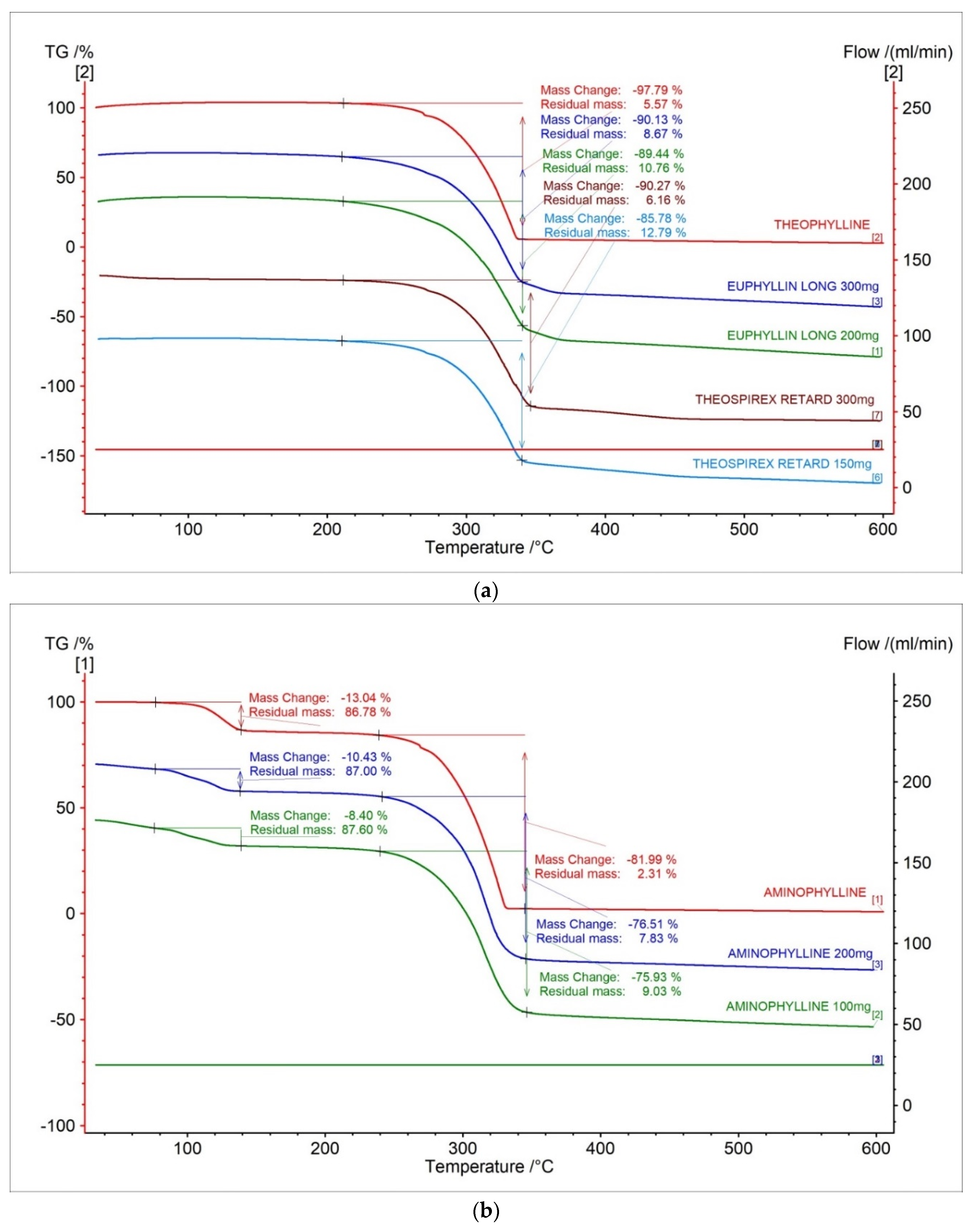
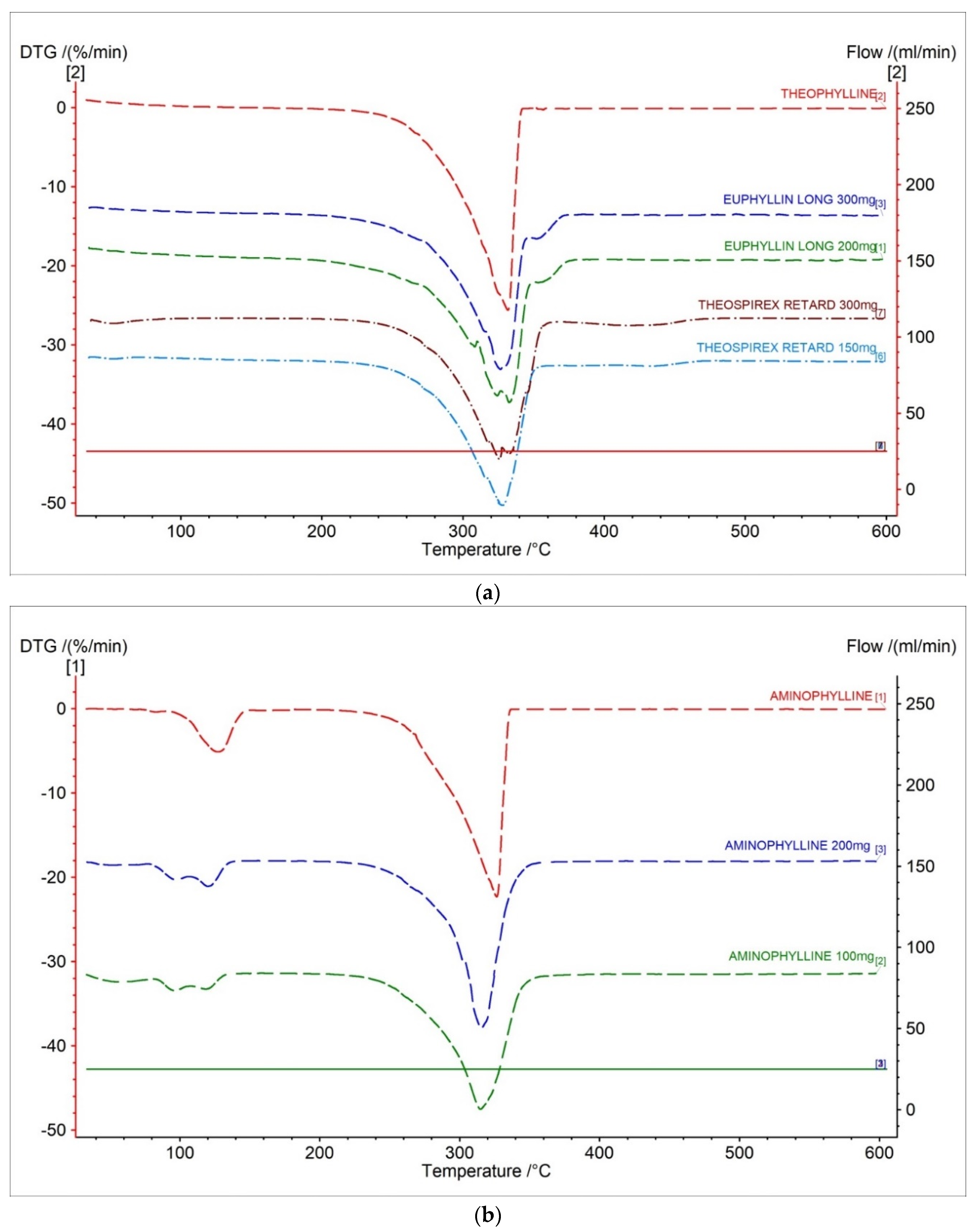
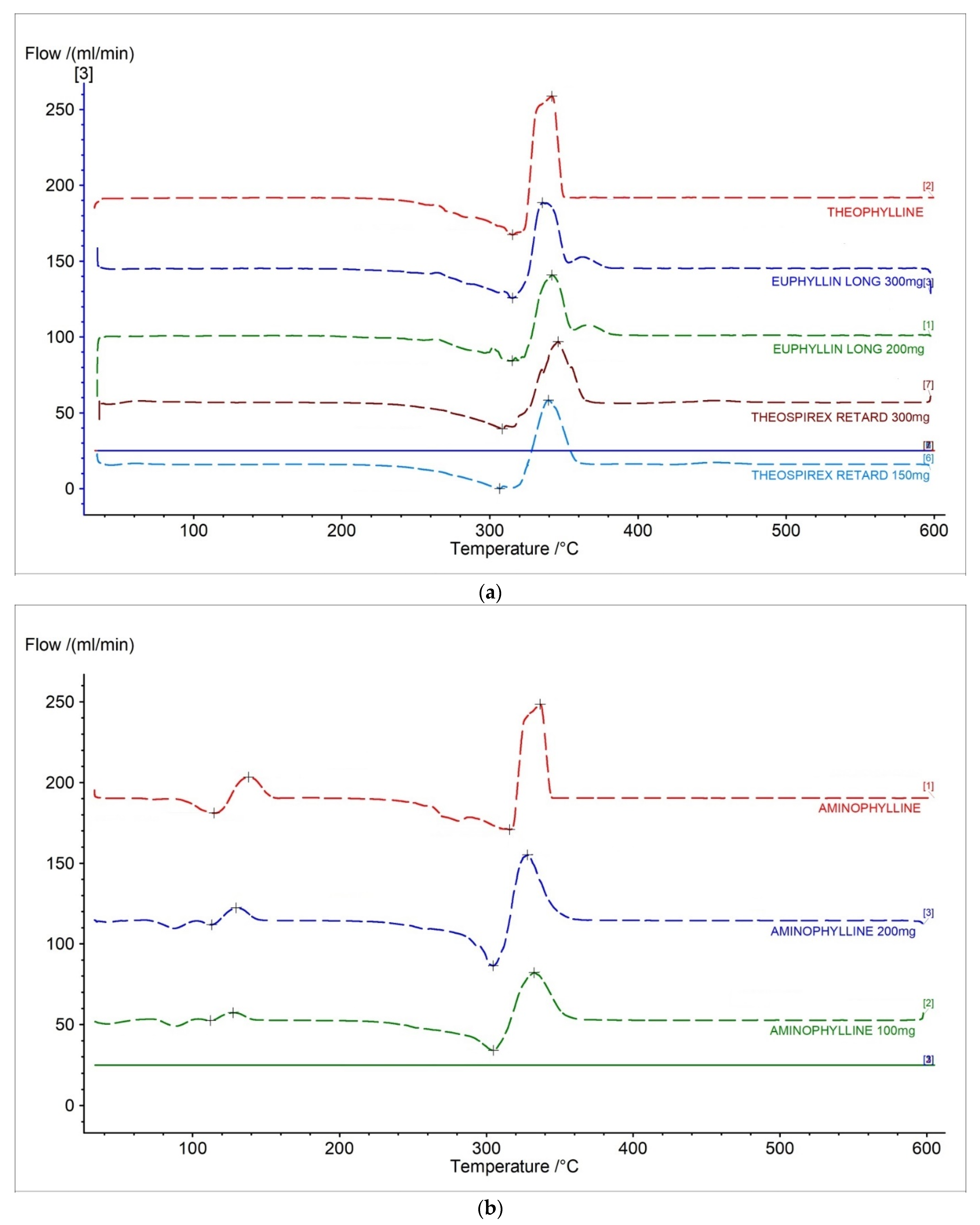
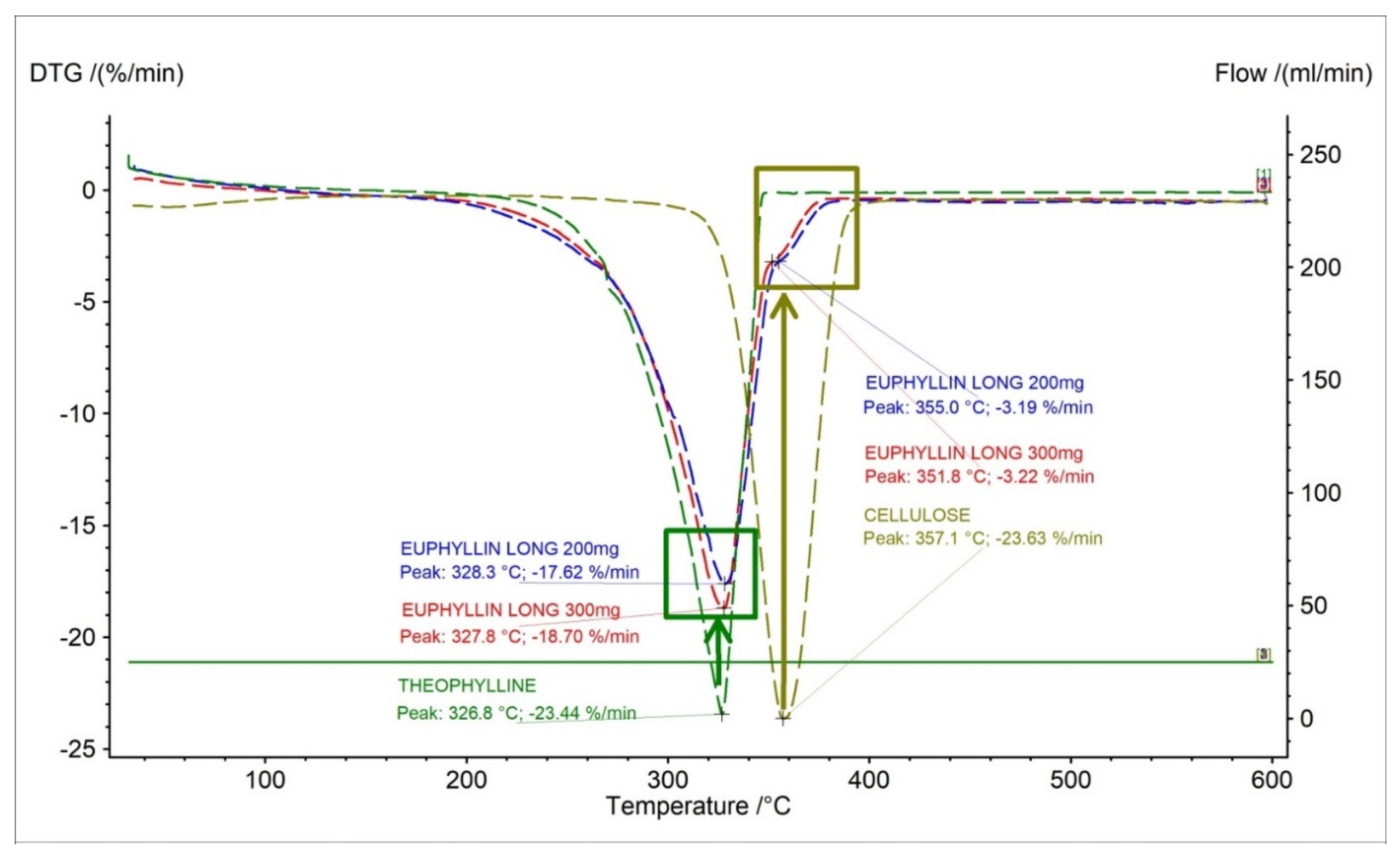
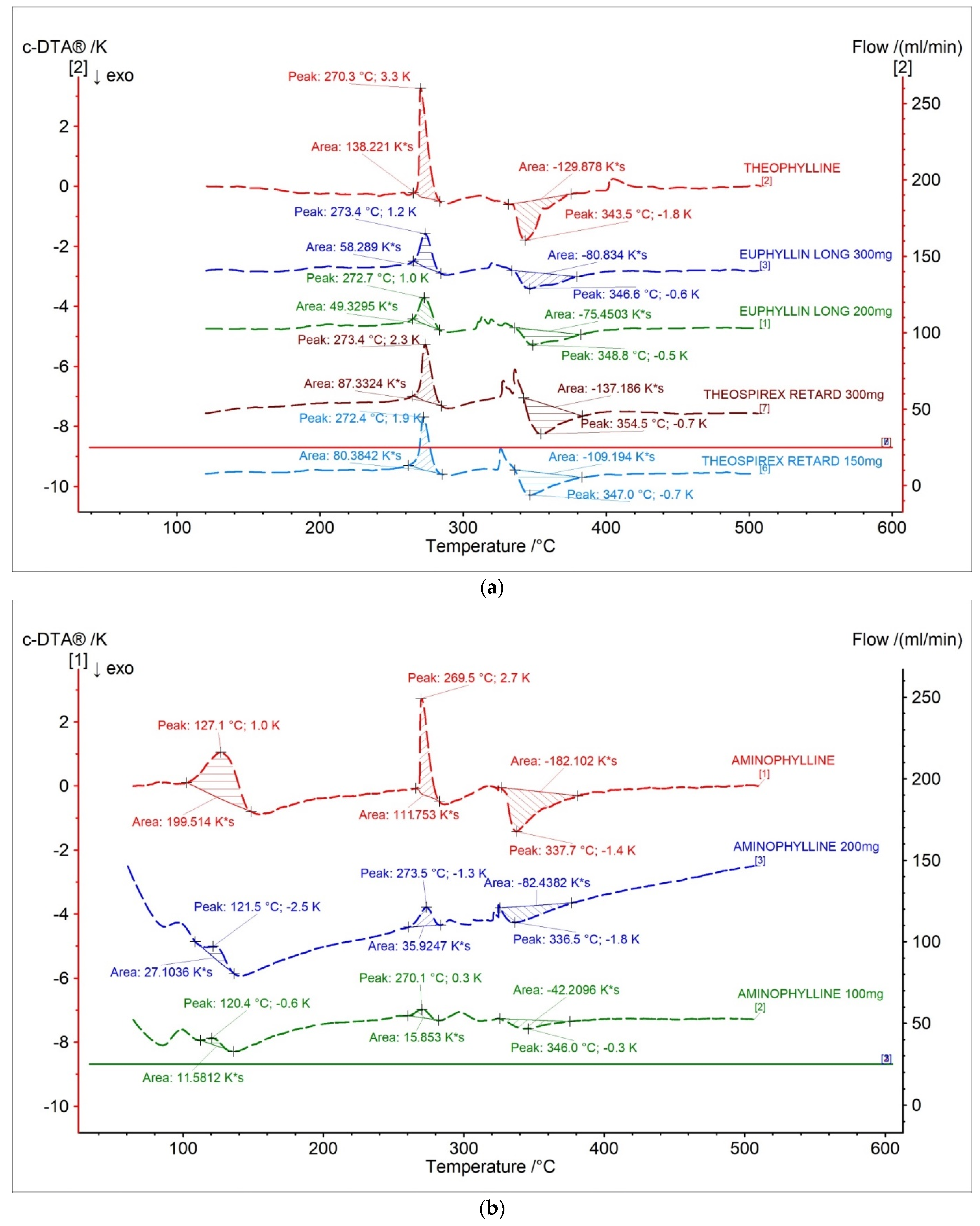
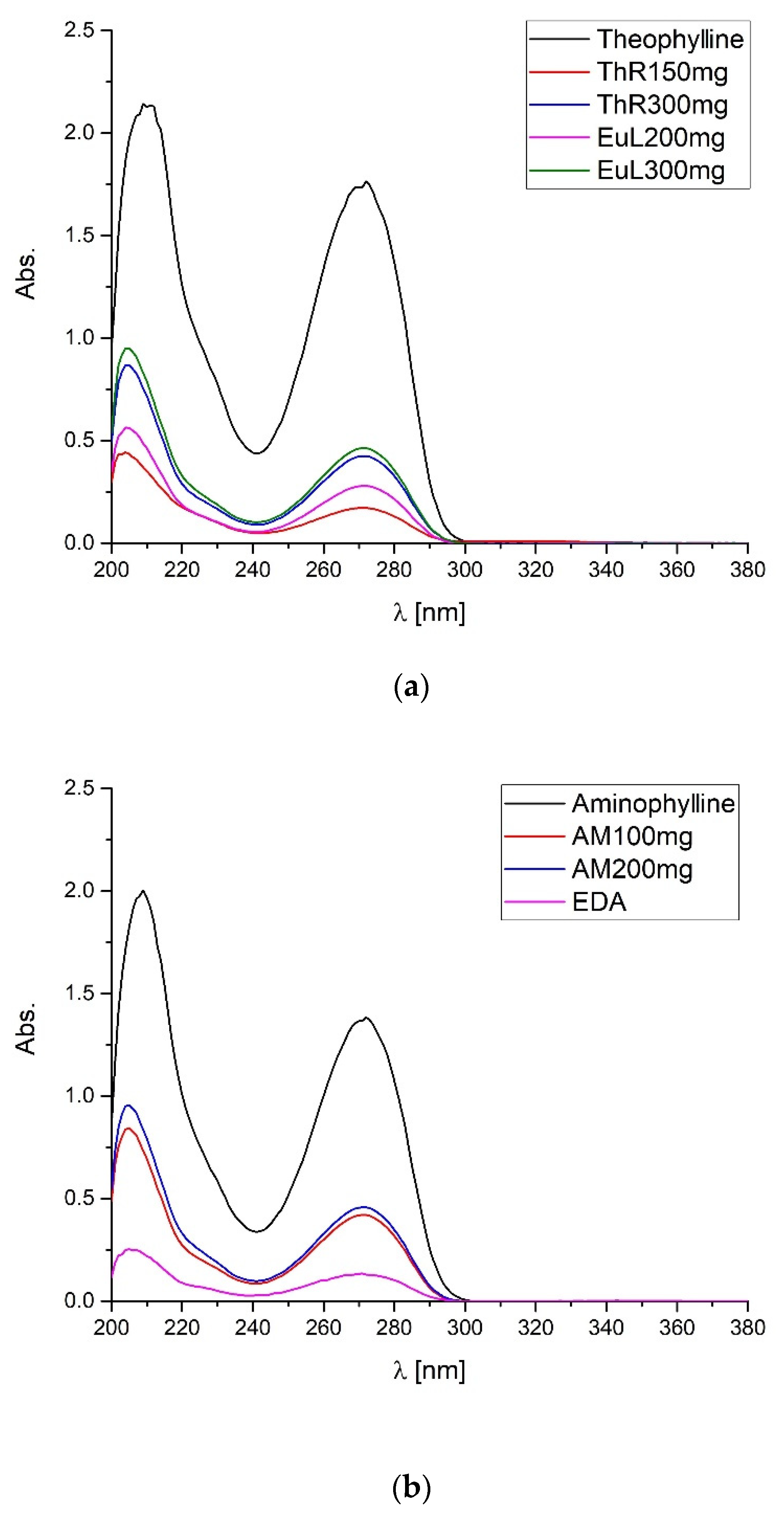
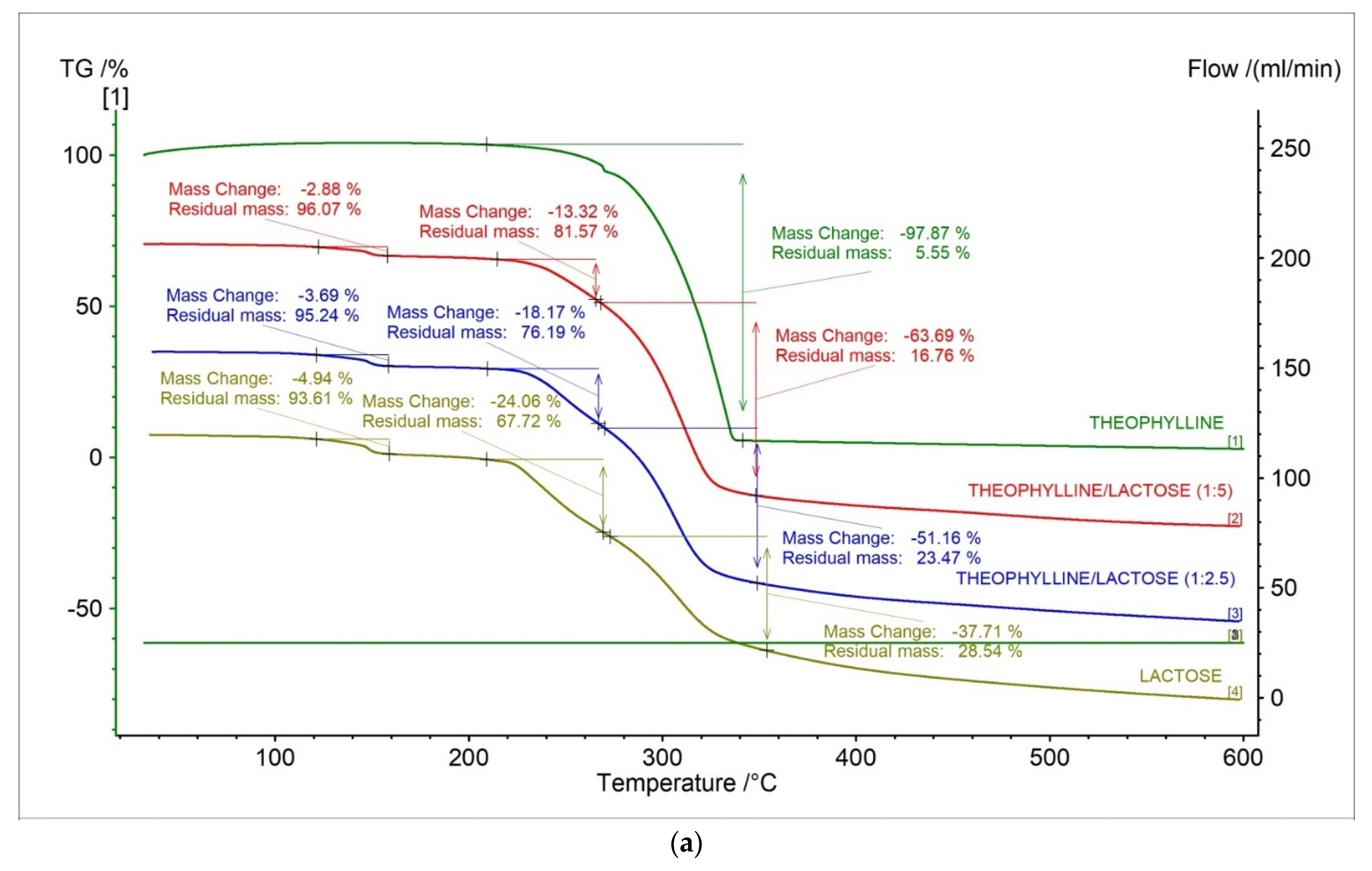
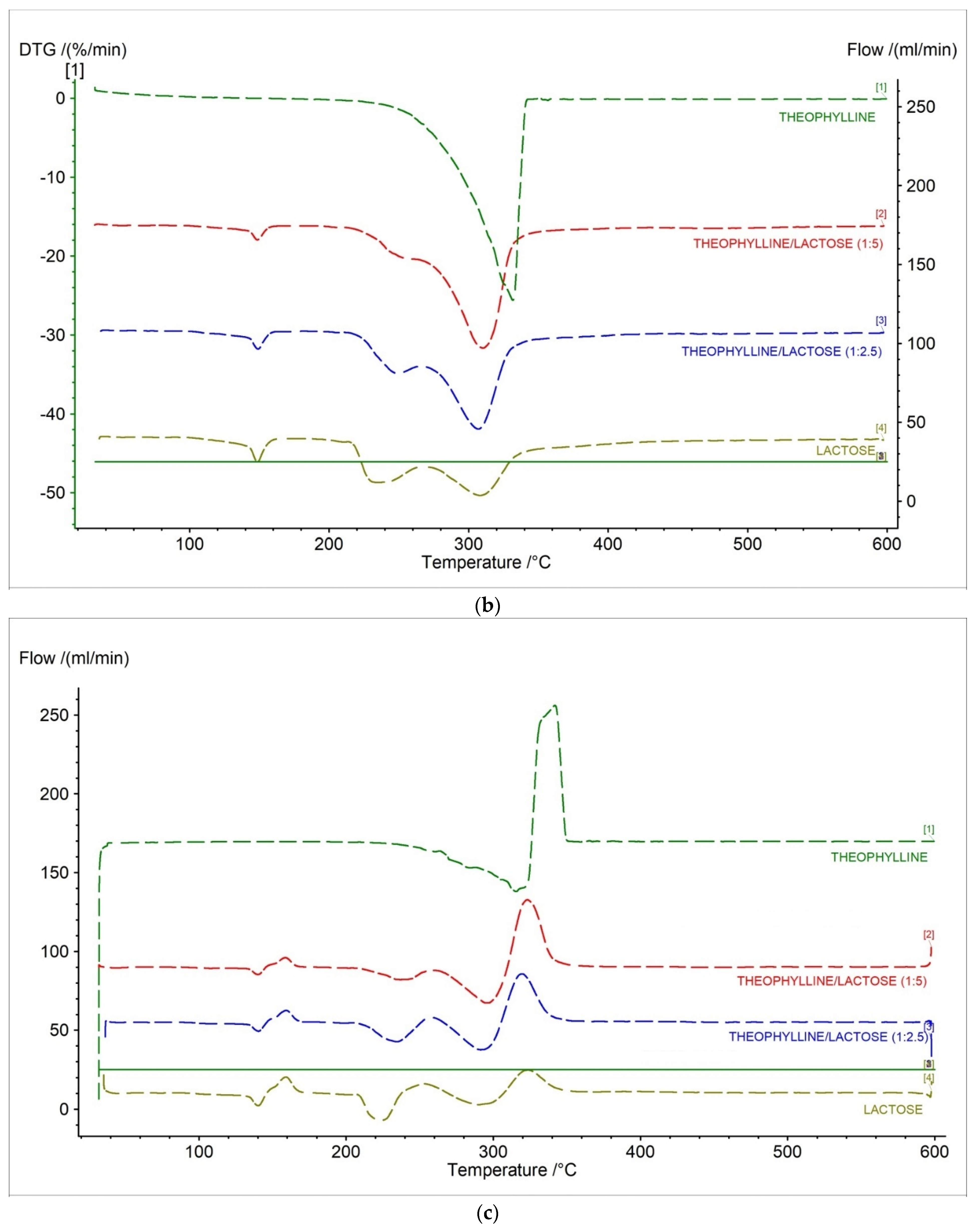
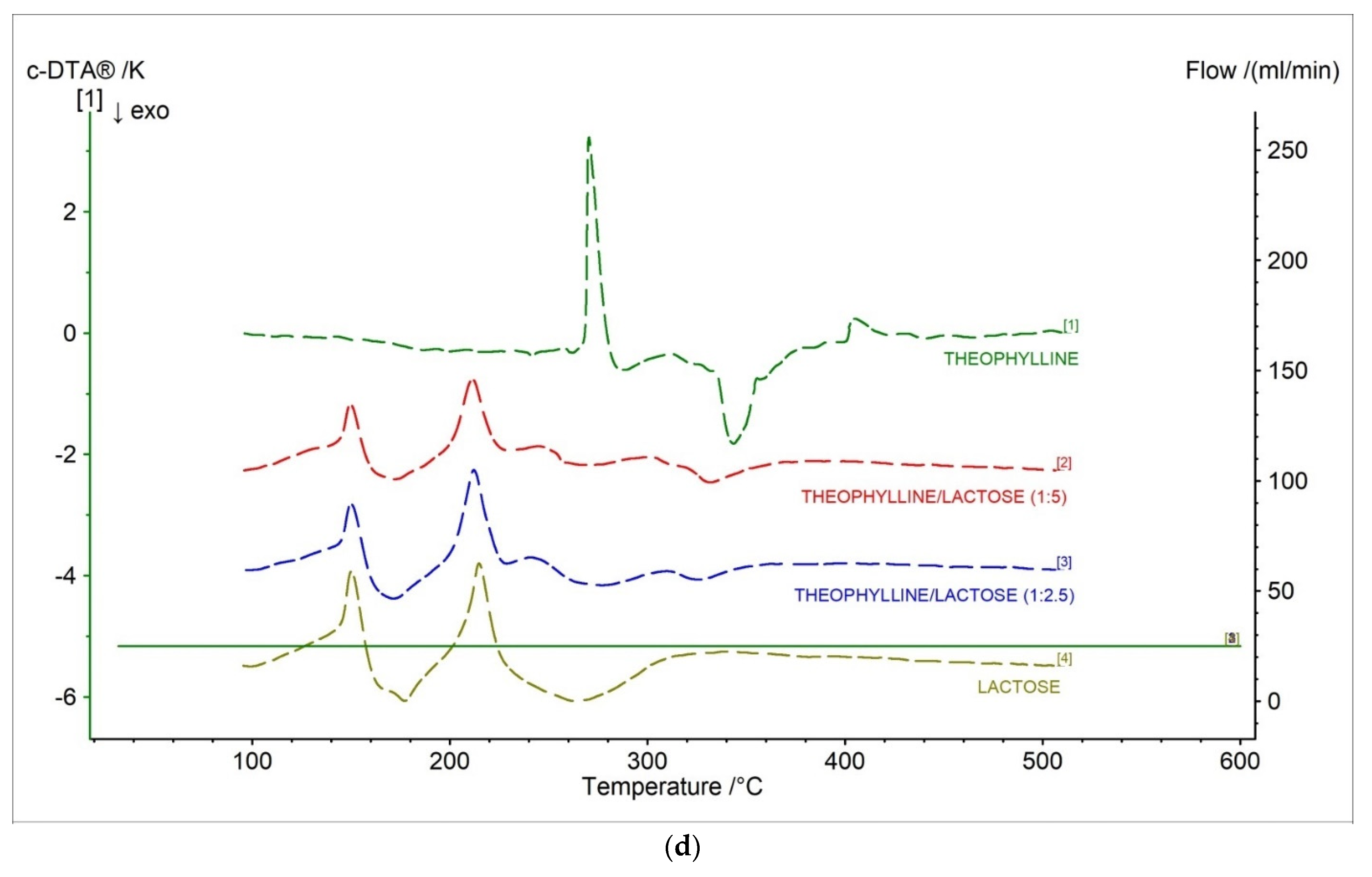
| Samples | Onset [°C] | Mid [°C] | Inflection [°C] | End [°C] | Weight Loss [%] |
|---|---|---|---|---|---|
| Theophylline | 298.6 | 314.7 | 333.6 | 336.3 | −97.79 |
| Euphyllin long 300 mg | 291.0 | 316.1 | 324.4 | 342.2 | −90.13 |
| Euphyllin long 200 mg | 289.7 | 316.8 | 331.3 | 345.1 | −89.44 |
| Theospirex retard 300 mg | 289.6 | 320.0 | 337.4 | 347.7 | −90.27 |
| Theospirex retard 150 mg | 294.5 | 317.1 | 331.8 | 341.8 | −85.78 |
| Aminophylline | 295.3 | 311.0 | 328.3 | 330.8 | −78.11 |
| Aminophylline 200 mg | 291.9 | 311.1 | 316.2 | 329.9 | −72.48 |
| Aminophylline 100 mg | 286.3 | 310.6 | 315.9 | 334.3 | −72.97 |
| Samples | Curve | Parameter | Stage I | Stage II |
|---|---|---|---|---|
| Theophylline | DTG | Peak [°C] | 331.7 | - |
| Mass change [%/min.] | −25.59 | - | ||
| D2TG | Peak min. [°C] | 315.4 | - | |
| Peak max. [°C] | 341.8 | - | ||
| Euphyllin long 300 mg | DTG | Peak [°C] | 326.5 | - |
| Mass change [%/min.] | −19.96 | - | ||
| D2TG | Peak min. [°C] | 315.3 | - | |
| Peak max. [°C] | 335.7 | - | ||
| Euphyllin long 200 mg | DTG | Peak [°C] | 332.8 | - |
| Mass change [%/min.] | −18.55 | - | ||
| D2TG | Peak min. [°C] | 315.1 | - | |
| Peak max. [°C] | 341.9 | - | ||
| Theospirex retard 300 mg | DTG | Peak [°C] | 325.8 | - |
| Mass change [%/min.] | −17.90 | - | ||
| D2TG | Peak min. [°C] | 308.4 | - | |
| Peak max. [°C] | 346.1 | - | ||
| Theospirex retard 150 mg | DTG | Peak [°C] | 328.1 | - |
| Mass change [%/min.] | −18.56 | - | ||
| D2TG | Peak min. [°C] | 306.8 | - | |
| Peak max. [°C] | 339.5 | - | ||
| Aminophylline | DTG | Peak [°C] | 127.3 | 326.5 |
| Mass change [%/min.] | −5.12 | −22.30 | ||
| D2TG | Peak min. [°C] | 114.7 | 316.0 | |
| Peak max. [°C] | 138.1 | 336.7 | ||
| Aminophylline 200 mg | DTG | Peak [°C] | 120.0 | 315.7 |
| Mass change [%/min.] | −3.15 | −19.90 | ||
| D2TG | Peak min. [°C] | 113.0 | 304.6 | |
| Peak max. [°C] | 129.7 | 328.1 | ||
| Aminophylline 100 mg | DTG | Peak [°C] | 118.5 | 314.9 |
| Mass change [%/min.] | −2.00 | −16.27 | ||
| D2TG | Peak min. [°C] | 112.1 | 304.7 | |
| Peak max. [°C] | 127.6 | 332.6 |
| Samples | Parameter | Peak I | Peak II | Peak III |
|---|---|---|---|---|
| Theophylline | Onset [°C] | 268.8 | 335.5 | - |
| Peak [°C] | 270.3 | 343.5 | - | |
| Type of reaction | endothermic | exothermic | - | |
| Area [K*s] | 138.221 | 129.878 | - | |
| Euphyllin long 300 mg | Onset [°C] | 267.3 | 334.3 | - |
| Peak [°C] | 273.4 | 346.6 | - | |
| Type of reaction | endothermic | exothermic | - | |
| Area [K*s] | 58.289 | 80.834 | - | |
| Euphyllin long 200 mg | Onset [°C] | 266.6 | 332.4 | - |
| Peak [°C] | 272.7 | 348.8 | - | |
| Type of reaction | endothermic | exothermic | - | |
| Area [K*s] | 49.3295 | 75.4503 | - | |
| Theospirex retard 300 mg | Onset [°C] | 269.9 | 338.6 | - |
| Peak [°C] | 273.4 | 354.5 | - | |
| Type of reaction | endothermic | exothermic | - | |
| Area [K*s] | 87.3324 | 137.186 | - | |
| Theospirex retard 150 mg | Onset [°C] | 269.0 | 332.0 | - |
| Peak [°C] | 272.4 | 347.0 | - | |
| Type of reaction | endothermic | exothermic | - | |
| Area [K*s] | 80.3842 | 109.194 | - | |
| Aminophylline | Onset [°C] | 108.6 | 268.5 | 324.7 |
| Peak [°C] | 127.1 | 269.5 | 337.7 | |
| Type of reaction | endothermic | endothermic | exothermic | |
| Area [K*s] | 199.514 | 111.753 | 182.102 | |
| Aminophylline 200 mg | Onset [°C] | 110.2 | 264.2 | 321.7 |
| Peak [°C] | 121.5 | 273.5 | 336.5 | |
| Type of reaction | endothermic | endothermic | exothermic | |
| Area [K*s] | 27.1036 | 35.9247 | 82.4382 | |
| Aminophylline 100 mg | Onset [°C] | 113.2 | 262.3 | 323.5 |
| Peak [°C] | 120.4 | 270.1 | 346.0 | |
| Type of reaction | endothermic | endothermic | exothermic | |
| Area [K*s] | 11.5812 | 15.853 | 42.2096 |
| Samples | Onset [°C] | Mid [°C] | Inflection [°C] | End [°C] | Weight Loss [%] |
|---|---|---|---|---|---|
| Theophylline | 298.6 | 314.7 | 333.6 | 336.3 | −97.79 |
| Theophylline/Lactose Ratio 1:5 (m:m) | 276.6 | 301.4 | 311.3 | 326.3 | −72.65 |
| Theophylline/Lactose Ratio 1:2.5 (m:m) | 268.9 | 297.0 | 306.6 | 325.3 | −65.76 |
| Lactose Monohydrate | 259.2 | 299.9 | 310.0 | 338.2 | −48.63 |
| Samples | Curve | Parameter | Stage I | Stage II | Stage III |
|---|---|---|---|---|---|
| Theophylline | DTG | Peak [°C] | 331.7 | - | - |
| Mass change [%/min.] | −25.59 | - | - | ||
| D2TG | Peak min. [°C] | 315.4 | - | - | |
| Peak max. [°C] | 341.8 | - | - | ||
| Theophylline/Lactose Ratio 1:5 (m:m) | DTG | Peak [°C] | 148.6 | 243.8 | 310.3 |
| Mass change [%/min.] | −1.91 | −3.42 | −15.63 | ||
| D2TG | Peak min. [°C] | 140.0 | 236.8 | 296.1 | |
| Peak max. [°C] | 158.6 | 259.6 | 323.1 | ||
| Theophylline/Lactose Ratio 1:2.5 (m:m) | DTG | Peak [°C] | 149.0 | 248.9 | 306.9 |
| Mass change [%/min.] | −2.37 | −5.45 | −12.52 | ||
| D2TG | Peak min. [°C] | 140.4 | 234.5 | 291.4 | |
| Peak max. [°C] | 159.2 | 257.4 | 319.6 | ||
| Lactose Monohydrate | DTG | Peak [°C] | 148.6 | 236.1 | 308.2 |
| Mass change [%/min.] | −3.24 | −5.84 | −7.49 | ||
| D2TG | Peak min. [°C] | 140.2 | 224.0 | 290.3 | |
| Peak max. [°C] | 159.0 | 253.3 | 323.7 |
| Samples | Parameter | Peak I | Peak II | Peak III |
|---|---|---|---|---|
| Theophylline | Onset [°C] | 268.8 | 335.5 | - |
| Peak [°C] | 270.3 | 343.5 | - | |
| Type of reaction | endothermic | exothermic | - | |
| Area [K*s] | 138.221 | 129.878 | - | |
| Theophylline/Lactose Ratio 1:5 (m:m) | Onset [°C] | 145.2 | 202.2 | 321.5 |
| Peak [°C] | 149.6 | 211.4 | 331.7 | |
| Type of reaction | endothermic | endothermic | exothermic | |
| Area [K*s] | 39.6189 | 80.9836 | 30.4644 | |
| Theophylline/Lactose Ratio 1:2.5 (m:m) | Onset [°C] | 145.6 | 202.9 | 314.0 |
| Peak [°C] | 150.0 | 212.1 | 326.4 | |
| Type of reaction | endothermic | endothermic | exothermic | |
| Area [K*s] | 49.3295 | 75.4503 | 19.1181 | |
| Lactose Monohydrate | Onset [°C] | 145.9 | 208.7 | - |
| Peak [°C] | 150.2 | 214.8 | 262.8 | |
| Type of reaction | endothermic | endothermic | exothermic | |
| Area [K*s] | 64.7497 | 115.725 | 160.254 |
Publisher’s Note: MDPI stays neutral with regard to jurisdictional claims in published maps and institutional affiliations. |
© 2022 by the author. Licensee MDPI, Basel, Switzerland. This article is an open access article distributed under the terms and conditions of the Creative Commons Attribution (CC BY) license (https://creativecommons.org/licenses/by/4.0/).
Share and Cite
Ramos, P. Application of Thermal Analysis to Evaluate Pharmaceutical Preparations Containing Theophylline. Pharmaceuticals 2022, 15, 1268. https://doi.org/10.3390/ph15101268
Ramos P. Application of Thermal Analysis to Evaluate Pharmaceutical Preparations Containing Theophylline. Pharmaceuticals. 2022; 15(10):1268. https://doi.org/10.3390/ph15101268
Chicago/Turabian StyleRamos, Paweł. 2022. "Application of Thermal Analysis to Evaluate Pharmaceutical Preparations Containing Theophylline" Pharmaceuticals 15, no. 10: 1268. https://doi.org/10.3390/ph15101268
APA StyleRamos, P. (2022). Application of Thermal Analysis to Evaluate Pharmaceutical Preparations Containing Theophylline. Pharmaceuticals, 15(10), 1268. https://doi.org/10.3390/ph15101268






